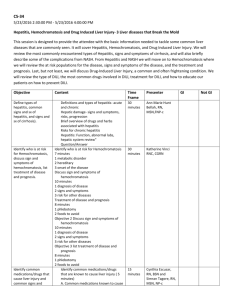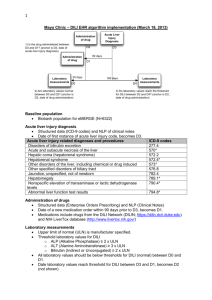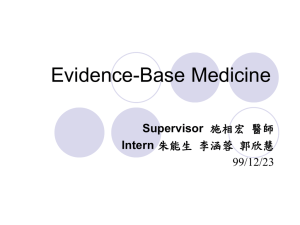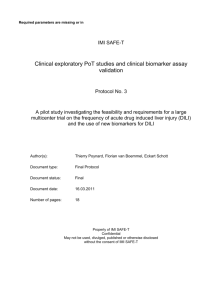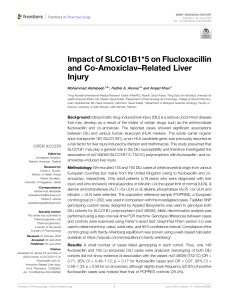MIP-DILI – Press Release, 29.03.12 Drugs that are kinder to the liver
advertisement
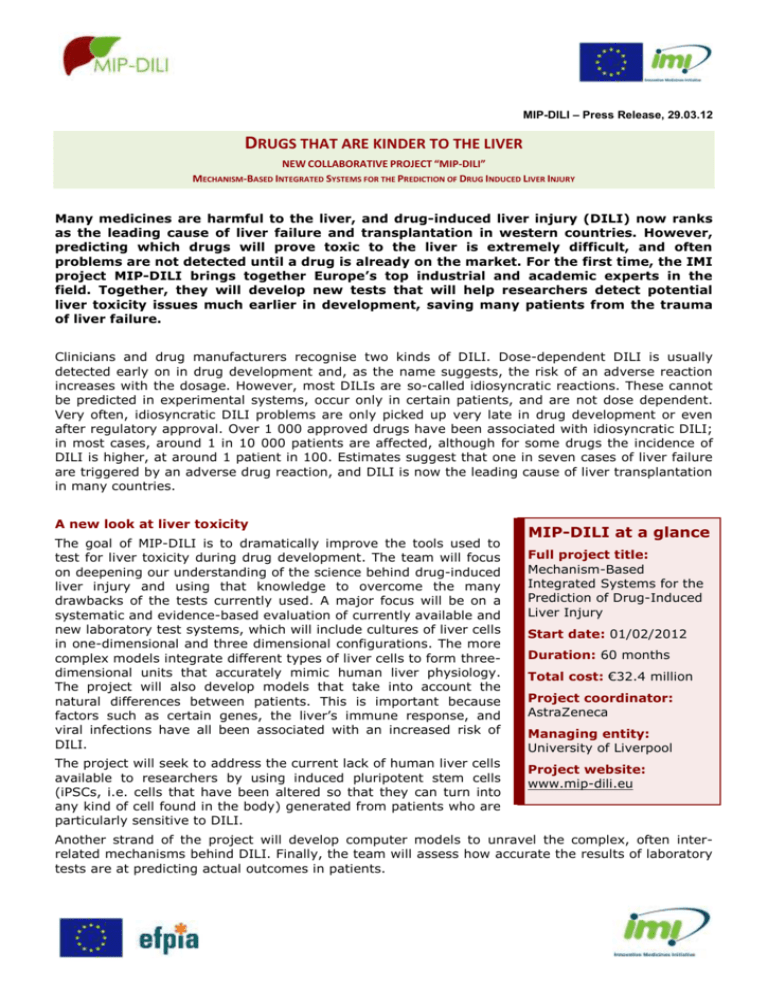
MIP-DILI – Press Release, 29.03.12 DRUGS THAT ARE KINDER TO THE LIVER NEW COLLABORATIVE PROJECT “MIP-DILI” MECHANISM-BASED INTEGRATED SYSTEMS FOR THE PREDICTION OF DRUG INDUCED LIVER INJURY Many medicines are harmful to the liver, and drug-induced liver injury (DILI) now ranks as the leading cause of liver failure and transplantation in western countries. However, predicting which drugs will prove toxic to the liver is extremely difficult, and often problems are not detected until a drug is already on the market. For the first time, the IMI project MIP-DILI brings together Europe’s top industrial and academic experts in the field. Together, they will develop new tests that will help researchers detect potential liver toxicity issues much earlier in development, saving many patients from the trauma of liver failure. Clinicians and drug manufacturers recognise two kinds of DILI. Dose-dependent DILI is usually detected early on in drug development and, as the name suggests, the risk of an adverse reaction increases with the dosage. However, most DILIs are so-called idiosyncratic reactions. These cannot be predicted in experimental systems, occur only in certain patients, and are not dose dependent. Very often, idiosyncratic DILI problems are only picked up very late in drug development or even after regulatory approval. Over 1 000 approved drugs have been associated with idiosyncratic DILI; in most cases, around 1 in 10 000 patients are affected, although for some drugs the incidence of DILI is higher, at around 1 patient in 100. Estimates suggest that one in seven cases of liver failure are triggered by an adverse drug reaction, and DILI is now the leading cause of liver transplantation in many countries. A new look at liver toxicity The goal of MIP-DILI is to dramatically improve the tools used to test for liver toxicity during drug development. The team will focus on deepening our understanding of the science behind drug-induced liver injury and using that knowledge to overcome the many drawbacks of the tests currently used. A major focus will be on a systematic and evidence-based evaluation of currently available and new laboratory test systems, which will include cultures of liver cells in one-dimensional and three dimensional configurations. The more complex models integrate different types of liver cells to form threedimensional units that accurately mimic human liver physiology. The project will also develop models that take into account the natural differences between patients. This is important because factors such as certain genes, the liver’s immune response, and viral infections have all been associated with an increased risk of DILI. The project will seek to address the current lack of human liver cells available to researchers by using induced pluripotent stem cells (iPSCs, i.e. cells that have been altered so that they can turn into any kind of cell found in the body) generated from patients who are particularly sensitive to DILI. MIP-DILI at a glance Full project title: Mechanism-Based Integrated Systems for the Prediction of Drug-Induced Liver Injury Start date: 01/02/2012 Duration: 60 months Total cost: €32.4 million Project coordinator: AstraZeneca Managing entity: University of Liverpool Project website: www.mip-dili.eu Another strand of the project will develop computer models to unravel the complex, often interrelated mechanisms behind DILI. Finally, the team will assess how accurate the results of laboratory tests are at predicting actual outcomes in patients. A leap forward for liver safety Until now, the quest to develop better tests for DILI risk in potential drugs has been hampered by a lack of collaboration between industry and academia. By bringing together experts from these sectors in a single, coordinated effort, MIP-DILI promises to both advance our understanding of drug-induced liver injury and deliver tests to detect it early on in drug development. Academic partners in the project will benefit from access to reference compounds, with known liver toxicity, that are held by pharmaceutical companies. For their part, pharmaceutical companies will gain a greater understanding of the complex science behind DILI. The stakes are high; all too often, DILI and other toxicity problems are only identified extremely late in drug development, when vast amounts of time and money have been spent on a potential drug. According to a report from the Society for Medicines Research, just a 10% improvement in predicting failure before the start of clinical trials could cut the costs of drug development by upwards of €75 million. Safer treatments for patients Although DILI is rare, when it happens, it is often extremely serious or even fatal for the patient concerned. Yet too many drugs that pose a risk of DILI still make it to the market, and DILI is a common reason for withdrawing drugs from the market. By helping researchers to detect DILI problems during drug research, before drugs are evaluated in clinical trials and are approved for use, MIP-DILI will prevent considerable pain and suffering on the part of patients. Project Partners EFPIA member companies Small and medium-sized enterprises (SMEs) AstraZeneca AB, Södertälje, Sweden Abbott GmbH & CoKG, Wiesbaden-Delkenheim, Germany Bristol Myers Squibb EMEA sarl, New York, US Glaxosmithkline Research and Development Ltd, Middlesex, UK H. Lundbeck A/S, Valby, Denmark Institut de Recherches Internationales Servier, Suresnes, France Janssen Pharmaceutica NV, Beerse, Belgium Merck KGaA, Darmstadt, Germany Orion Corporation, Espoo, Finland Sanofi-Aventis Research and Development, Chilly-Mazarin, France UCB Pharma SA, Brussels, Belgium Cellartis AB, Göteborg, Sweden CXR Biosciences Ltd., Dundee, UK Interface Europe, Brussels, Belgium KaLy-Cell, Illkirch, France Lhasa Ltd., Leeds, UK Solvo Biotechnology ZRT, Szeged, Hungary Contacts Project Coordinator AstraZeneca AB Managing Entity University of Liverpool Universities, research organisations, bodies, non-profit groups public University of Liverpool, Liverpool, UK Albert-Ludwigs-University Freiburg, Freiburg, Germany Deutsches Krebsforschungszentrum, Heidelberg, Germany Karolinska Institutet, Stockholm, Sweden Universitaetsklinikum Bonn, Bonn, Germany Université de Rennes 1, Rennes, France Universiteit Leiden, Leiden, Netherlands Universiteit Utrecht, Utrecht, Netherlands VU University Amsterdam, Netherlands Further information is available from: Interface Europe Tel: +32 2 2130030 e-mail: monique.marrec-fairley@interfaceurope.eu Financing IMI funding €15.3 million EFPIA in kind contribution €11.0 million EFPIA US contribution €1.6 million Other contributions €4.5 million Resources are composed of a financial contribution from the European Union's Seventh Framework Programme (FP7/2007-2013) and EFPIA companies’ in kind contributions. Other contributions €4.5 million Total project cost €32.4 million This project is funded by the Innovative Medicines Initiative (IMI), a public-private partnership between the European Union and the European Federation of Pharmaceutical Industries and Associations (EFPIA), under Grant Agreement 115336
